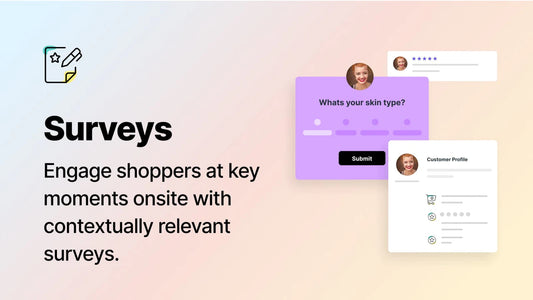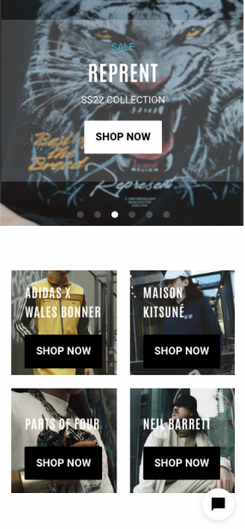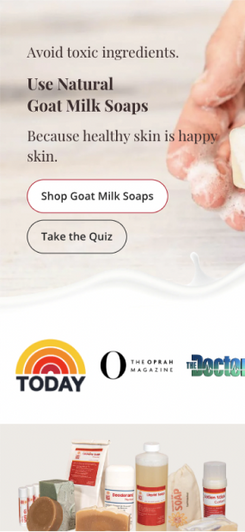Here at Blend, we are always looking at ways to change or improve our brand. After some team discussions, we have decided to delve deeper into our brand by analysing what Archetype groups we fall into and a full website and brand redesign are already taking place. We’ll share updates as soon as we’re ready to share.
Given that our findings were hugely insightful, we wanted to share these with our clients and other Shopify merchants to help them understand and build on to strengthen their brand in the long run. In this article we explain:
- The ideas behind ‘Archetypes’ concept
- The 12 Archetypes with brand examples
- An analysis of Shopify stores and their key archetypes
What is an Archetype?
An archetype is the appearance of a brand’s relationship to their behaviour and the psychological theories behind it all. They set the tone of a brand as well as the emotions. In simple terms, an archetype is like a ‘personality’ and dictates how that brands ‘personality’ reacts and affects people in different situations.
In today’s society, brands are increasingly determined by relationships and their interactions. In addition to this, they give you a deeper understanding of purpose from the brand. Where brands are seeking new methods, archetypes achieve more by adding engagements that are powerful and in turn will give a better user experience.
Within the branding scene, there are 12 archetypes, each with its own unique approach. When shopping, booking with or even browsing a brand, they always fall into at least one of the 12 archetype categories, and commonly fall into 2-3.
The 12 Archetype Categories
The Innocent
These are the optimistic, idealistic and hopeful brands. Its sole purpose is living harmoniously with one and all. The desire it has for life translates into love, happiness and most importantly peace. The main goal of this archetype is to always be happy and optimistic and to see the glass as half full rather than half empty.
The way it goes through in life is doing right and always being positive. The one thing it really fears is when it gets punished for something they have done wrong. So with the Innocent archetype - it speaks with the utmost honestly acting with integrity and most of all, it thinks with innocence.
The Innocent archetype offers simple and flexible solutions and it’s affiliated with being good, nostalgic and simple. It’s fairly priced by an organisation that is somewhat straight forward with their values and its needs are to be different from similar brands that have underperforming rapport. The Innocent has strong trustworthy values, where it wants to be seen for its honesty and reliability.
Examples of brands that fit into the Innocent archetype are Pampers, Dove and Coca-Cola.

The Everyman/woman
The purpose of this archetype is to be accepted and embrace others. The Everyman enjoys having people around who know and accept them. Having an inviting tone, being warm and friendly is often the focus and in turn, serves the needs and interests of people. The desire to be dependable and trustworthy is key. There is a sense of community, warmth and unity in everything that is produced because being down to Earth is the main aspect of the everyman archetype.
The Everyman gives a sense of security and belonging and has a common touch to give a sense of belonging.
Examples of brands that fit into the Everyman archetype are Ikea, eBay and Budweiser
The Explorer
The brands that fit into the explorer archetype are somewhat curious, independent and naturally authentic about their approach to the world around them. Their main feature is the joy of being free, adventurous and discovering something new. The Explorer’s goal is to be exciting and live their lives to the fullest. There is only one thing this archetype fears, and that is the feeling of being trapped and aimlessly not being ready to wander freely.
Explorer brands are sturdy and never stay on one fixed path. They are normally associated with the outdoors or wandering into danger. This form of an archetype within websites, allows users to purchase whilst they are on the move. It never wants to be like the average person or a conventional brand. Explorers take risks; they are exciting and real and create a new experience that is long-lasting.
Examples of brands that fit into the Explorer archetype are Land Rover, Go Pro and Jeep.

The Caregiver
This is more of a dedicated nurturing archetype that is compassionate about what it stands for. Their main purpose is to help others in need. The Caregiver wants people to feel nurtured and secure. It’s highly focused on compassion, generosity, and nurturing; helping others to do things that other archetypes do not want to do. Their main fear is to feel neglected and vulnerable; opening themselves up to being exploited.
The Caregiver’s entire ethos is to ‘just stay good’. Therefore the caregiver gives their consumers an advantage that is competitive. It supports everyone and everything whilst staying connected beside the care of others. It serves all types of sectors, such as the fast-food industry, car industry and the public sector.
Examples of brands that fit into the Caregiver archetype are Water Aid, Johnson and Johnson and Pampers.

The Ruler/Sovereign
Confident, responsible and very honest; this archetype’s goal is to be the brand that people look up to. The desire of The Ruler is having complete control, by creating a successful community that is prosperous. They set out for themselves to be the influencers and power over it all. They fear being demoted or overthrown by a rival brand that gains more power. It will learn or win and it’ll surely never lose.
The Ruler archetype is very much used by brands that are high-end - where powerful users are magnifying their own power status. It offers a guarantee of empowerment and has a protective motive. The Ruler is normally the business leader, offering stability and much-needed security in a world that is very much chaotic. This also, therefore, helps consumers be more assured that they are in control of their own world.
Examples of brands that fit into the Ruler archetype are Rolex, Apple, Microsoft, and Hugo Boss.
The Magician
This archetype is insightful, hugely inspiring and has the ability to transform the ordinary to extraordinary. Magician brands are serving success over change; turning dilemmas into great opportunities, which in turns empowers teams, networks and the company’s individuals. They want to wonder and amaze, by unveiling answers where they have produced something from nothing. The Magician makes the impossible become possible and to make all dreams really come true. A fear of failure and consequences that are negative and being manipulated is something that is apparent with this archetype.
It’s an implicit archetype that transforms consumers' services by promising a better quality of life and expanding new things to become more user-friendly. Brands that hold this as one of their archetypes could be a contemporary brand where it helps transform people’s worlds by expanding the consciousness of change.
Examples of brands that fit into the Magician archetype are Disney, Dyson and Apple.

The Rebel or The Outlaw
The Outlaw archetype is often thought of as unconventional yet dynamic thinkers with a flair for rule-breaking. They shake things up and stand for what they believe in. They make others feel uncomfortable and hope to evoke everlasting change - even if it isn’t right, but socially accepted. It feels powerful when it’s revolutionary, and how it does this is by overturning what’s not working. The Outlaw’s fear is feeling useless or powerless and it fears that it could cross that line very easily.
The Outlaw is an archetype that makes people feel like they are not part of a particular franchise, but rather revolutionary and they are an advocate for allowing consumers to break the norm and be different.
Examples of brands that fit into the Outlaw archetype are Diesel, Netflix and Uber.

The Entertainer/Jester
This archetype is humorous, spontaneous and playful, with its sole purpose to make people simply feel good. They encourage people to appreciate themselves and always want to lighten the mood. This archetype desires to have fun and whilst doing that, relish life by bringing laughter to those across the globe. They live by the motto of ‘time is way too short’ and their main fear is being bored and flavourless.
To the Jester Archetype, laughter is the cure for everything and gives consumers a real feeling of belonging by encouraging them to just have a really great time. Brands that associate well with this archetype are normally fun and warming companies; that are fairly priced and are in no way self-absorbed.
Examples of brands that fit into the Jester archetype are McVities and Ben & Jerrys.
The Lover
This archetype is the one that everyone adores as it is passionate, committed and appreciative. The Lover’s main purpose is to make consumers feel really special. They are all about being intimate and having a unique connection with customers, to make them feel that they are the most important person to them. The Lover implies that they are all about romance, however, this is not the case. They are more about a long-lasting relationship with the customer through indulgence and luxury. There are 5 different types of emotions of love: spiritual, romantic, friendship, familial and parental. These all connect with each other through the power of love and relationships. The one thing that the Lover Archetype wants is to remain sought after as it’s fear is to be alone, unloved and worst of all unwanted.
Brands that identify with this archetype are ones that help customers to belong; to find a partner or friend. They show consumers how to have a good time, by structured loving relationships through connection and building trust.
Examples of brands that fit into the Lover archetype are Häagen-Dazs, Magnum and Dior.

The Sage
This archetype is knowledgeable, reflective and intelligent.
Having the thirst for knowledge without being arrogant is what this archetype is all about. The purpose of being sage is to find solutions to the problems that anyone can have. They constantly want to know the real truth and want everything to be perfect. The Sage archetype prides itself on being in the know and it enjoys sharing these findings to others, to really help benefit all. Finding the truth and to use that knowledge to understand the world, the Sage archetype will stop at nothing for the real truth to be known to all, but what it really fears is to be misled or fooled. Their motto is that ‘every day is a teaching day'.
The expertise and the information known about their customers and users encourages them to reflect; basing all this on best practices and industry experience. Simply knowing a lot is not the only thing; they are constantly learning and researching, and want to differ from their competitors, whose performance or quality is not up to scratch. Helping better people's understanding of the world around them provided by a sea of analytics and best-practised research is key to this archetype.
Examples of brands that fit into the Sage archetype are Google, Philips and the BBC.

The Creator/Creative
This archetype is one that most companies think they are but is actually only relative to a select few. It’s very expressive, imaginative and original. The purpose of this archetype is to take ideas and turn them into something new. They love things that are unusual and unique and are attracted by clever visions that strive in a direction that demonstrates individuality and personality.
Their main goal is to turn ideas into reality, to result in a perfect service or product. Whilst having an idea is great, a Creator also brainstorms and problem-solves before it reaches the end goal. The only thing that they truly fear is having their creativity blocked.
The brands that fall under this archetype category promote themselves as being self-expressive, by giving choices to their customers and harnessing their artistic flair. They want to differentiate themselves from the competition by having room to imagine and allowing their customer to also express their creativity too.
Examples of brands that fit into the Creator archetype are Lego, Adobe and Apple.
The Hero
The Hero is a focused and determined archetype that achieves by being the one that people turn to. They prove their worth through courageous acts that improve the world. The strategy of motivation, supporting and to be brave is what underlines the hero archetype. Being weak, scared and vulnerable is their fear. When faced with a difficult situation, the Hero rarely says ‘why me’, but instead ‘try me’.
Heroes are innovators that impact the world and help people to be who they want to be. They solve problems and encourage people to do so too. Their clear battle strategy and true passion is helping others through tough times and making them exceptional. Brands that are associated with this archetype are ones that have a clear goal in life and are at the top of their game without being arrogant or pretentious.
Examples of brands that fit into the Hero archetype are Nike, Coors and Red Cross.
Examples of Archetypes within Shopify stores
As Blend are Shopify experts, we thought it is worth us mentioning a few Shopify stores and what we think are their corresponding archetypes. This should then, in turn, help you visualise who they are and decide for yourself if you think they correctly fall into these archetypes.
Alo Yoga
This store from first glance is very much the rule-breakers and is different and edgy; displayed through their language and unique approach tone. They also have a caregiving side to them - giving classes and helping people celebrate all things yoga and have a thirst for exploring the potential of Yoga with their motto of ‘Bringing Yoga to the World'
Result - The Rebel, The Caregiver and The Explorer.

EightVape
They say they are ‘the best online vape store’ which implies that they are straight to the point and very much the rulers. However, they state that they are friendly and knowledgeable which suggests that they are experienced in this field and teach others. Other words that stand out are ‘Confident’, ‘Friendship’ and ‘Quality’, which leads me to think that they have a passion and want to share that with others.
Result - The Ruler, The Sage and The Lover
Natural Baby Shower
Already by the colours and the tones, you can tell that they care about their consumers and consider themselves as the Caregivers. They have a style that showcases an innocent approach and appetite in discovering more about the natural world and our little ones.
Result - The Caregiver and The Innocent

Peak Design
An outdoor brand - so for sure clearly for those explorers of the world. They also say that they are the leaders of what they do - priding themselves to create an elegant design for their consumers. They also have a little fun whilst doing it, however, they are not a brand who are funny as they are more serious than that. One thing that they say on their website suggests that they also give back what they have learnt for a more positive experience and change.
Result - The Ruler, The Hero and The Sage
Raycon
This brand already from the get-go says that they are the everyday brand; one that you can rely on. With some of their imagery, they suggest that they have a more-edgy and quirky character about them - that’s including their tone of voice too. All this under the wing of luxury and premium.
Result - The Everyman, The Jester and The Ruler

ThirdLove
They challenge the status quo by creating unique products. They are to the point and know what they are doing. They have identified a gap and they have created something that is inspiring and caregiving. They are community-driven with their approach making for lasting change.
Result - The Rebel, The Creator, The Magicians and The Caregiver
Testing your Companies Archetypes
After reading the above, you may be wondering what category your company falls into. This link is a useful and fun test that can give you an insight into your brand's archetypes.
Give it a go, and once you are done, please share your responses with us.
If you would like to chat about any of the archetypes further or anything else that Blend can help you with, then you can contact us via the following link:







